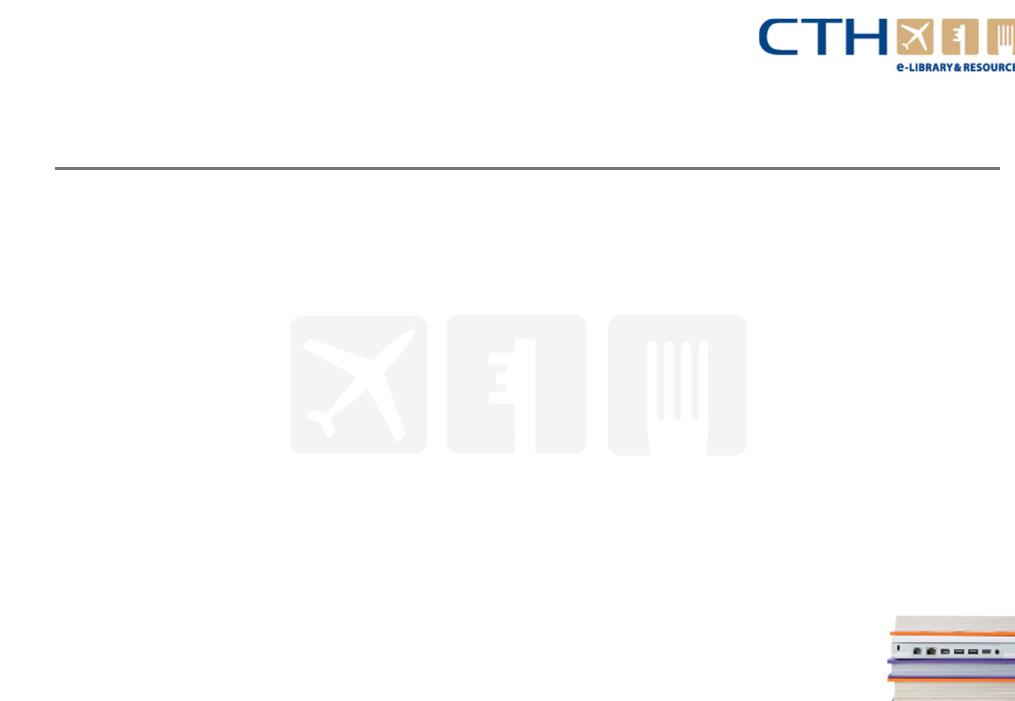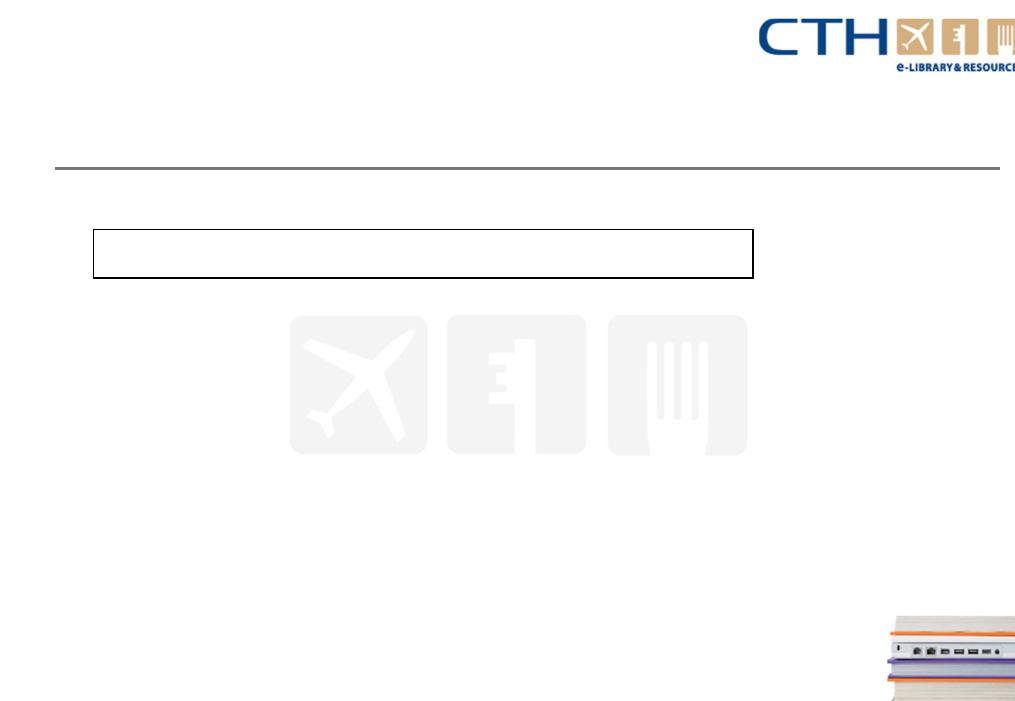
Front_Office_Operations
.pdf
Chapter 6– Yield management, statistics and reports
Yield management
1.1 Decisions involved in yield management
The profitability of different types of business
Corporate account holders, especially those who are prepared to guarantee a certain volume of bookings per year, may have a negotiated rate which is anything from 40% - 90% of rack rate, depending on volume. On the other hand, the guaranteed volume business makes them particularly profitable for the hotel
Travel agents and tour operators commonly charge a 10-20% commission on accommodation bookings, depending on volume, which is effectively a discount on rack rate
Independent leisure guests are nowadays likely to be quoted discounted 'best available rates’ in return for guaranteed advance bookings (which represent secure income) or online bookings (which save on administration costs), but they are more likely to pay something close to the rack rate
www.cthresources.com |
Page 331 |
|
www.cthawards.com |

Chapter 6– Yield management, statistics and reports
Yield management
1.1 Decisions involved in yield management continued…
At the same time, however:
Business customers tend not to be 'price sensitive': that is, their choice of hotel isn’t mainly driven by competing or changing prices. They are often prepared to pay higher rates (and to spend more on extras during their stay) because the company is paying their expenses.
Leisure customers are generally more 'price sensitive' because they are paying their own bills; they have a longer planning horizon to make price comparisons and go 'bargain hunting’ and they have a much wider choice of destination. {Tourists can choose to go to a cheaper hotel or destination, where a business traveller may be tied to a particular location and/or a hotel with which his employer has an account.)
www.cthresources.com |
Page 332 |
|
www.cthawards.com |

Chapter 6– Yield management, statistics and reports
Yield management
Advance bookings
Guaranteed advance bookings offer stability and secured revenue for the hotel, and again, different market segments show different patterns in this respect.
●Leisure travellers tend to book in advance, when they plan their holiday arrangements.
●Group tours (and conferences) tend to have particularly long 'booking horizons', because they need to reserve large blocks of rooms: they may make reservations up to two years in advance, so that they can secure accommodation for the group (particularly in busy tourist destinations) and advertise hotels in advance to prospective customers.
●Business travellers tend to make last-minute bookings, because many business trips are scheduled at short notice.
www.cthresources.com |
Page 333 |
|
www.cthawards.com |

Chapter 6– Yield management, statistics and reports
Yield management
The dilemma (in a nutshell)
These two main variables create a dilemma for the hotel.
Leisure travellers book up well in advance - but they generally earn the hotel less revenue, overall, than business customers. If hotel fills up with advance leisure bookings, it may have to turn away later - but more lucrative - corporate bookings. (Worse: the business customers you turn away will go to a competing hotel, which may therefore earn more than you do!)
On the other hand, If you turn away leisure bookings to reserve rooms for late-booking corporate customers, you are running the risk that the bookings may not materialise - and some revenue is better than the risk of none at all!
www.cthresources.com |
Page 334 |
|
www.cthawards.com |

Chapter 6– Yield management, statistics and reports
Yield management
1.2 When is yield management appropriate?
Yield management depends on reserving blocks of rooms for more profitable market segments - and only making those rooms available to less profitable market segments when necessary to stimulate demand. However, this will only work when overall demand is high, so that it is possible to anticipate and exploit late, high-yield bookings.
Moreover, as a formal technique, yield management depends on large amounts of statistical data, forecasts and calculations. It is, therefore, most appropriate for large, busy hotels (of at least 50 rooms) which generate sufficient amounts of information on occupancy and revenue to make such analysis (a) meaningful and (b) cost-effective to perform!
www.cthresources.com |
Page 335 |
|
www.cthawards.com |

Chapter 6– Yield management, statistics and reports
Yield management
1.3 Computerised yield management systems
A computerised yield management system automates all the 'juggling' out of yield management calculations and reservations, sparing staff a complex and time-consuming task. It is able to keep track of a wide range of forecasting data, and responds more flexibly to changes In booking levels: swiftly recognising where demand is getting ahead of, or falling behind, forecast, at any given time. The system can then support reservations clerks In making the optimum choices about what bookings to take and at what price.
The system accesses the database of all historical guest information, fluctuations in demand, room rates and sources of business. In addition, data can be input on local events and other factors which might attract higher demand in a certain period. On query by the operator, it can:
●Analyse the profit potential (and affect on average room rate) of each booking
●Analyse 'what if questions about the impact of different combinations of bookings on yield
●Suggest room rates, alternative booking dates or room allocations, and other courses of action (e.g.. refusing a booking because of the Iikelihood of better profitability later) to maximise yield.
www.cthresources.com |
Page 336 |
|
www.cthawards.com |

Chapter 6– Yield management, statistics and reports
Guest statistics
2.Guest statistics
2.1Average length of stay
2.2Guest origin
2.3Average guest expenditure
2.4Source of booking
www.cthresources.com |
Page 337 |
|
www.cthawards.com |

Chapter 6– Yield management, statistics and reports
Guest statistics
Guest statistics are data compiled about the guests who have stayed in the hotel. Much of the data on individual guests will be gathered in any case, during reservation, registration and guest accounting. When these compiled in various ways, they present a picture of activity in the hotel, which can be used to support staffing, marketing and other types of decisions.
2.1 Average length of stay
Question: How many people are typically staying at any one time, how long, on average, do they stay?
Purpose: This information will be used to support a range of managerial decisions: staffing levels and rosters; facilities to be offered (are you catering for short-stays or longer-staying guests who need more varied facilities?); housekeeping requirements (how often do linen and towels need to be changed?; how frequently are rooms prepared for re-Ietting?); and so on.
Calculation: There are two main ways of calculating an average' length of stay.
www.cthresources.com |
Page 338 |
|
www.cthawards.com |

Chapter 6– Yield management, statistics and reports
Guest statistics
The mean average is the total value of items divided by the number of items.
Total number of sleeper night sold in a given period / Number of guests
A mode is the most frequently occurring item in a set of statistics: in this case the most frequently occurring length of stay - from our data, two nights.
We can also see that 40 out of 50 (or 80%) of our guests stay for two nights or less: the hotel will either want to focus its facilities on this type of guest, or work harder to attract long-stay guests.
www.cthresources.com |
Page 339 |
|
www.cthawards.com |

Chapter 6– Yield management, statistics and reports
Guest statistics
2.2 Guest origin
Question: Where do guests come from?
Purpose: This information will be used to support hotel marketing (which areas offer 'ripe‘ audiences for advertising and sales campaigns?) and services offered (e.g.. which language will most likely be spoken by guests, which may require translation or the presence of multi-lingual staff? What cultural differences will need to be taken into account?)
Calculation: The nationality of guests is logged at registration. A computerised system can automatically provide a breakdown of guests by nationality and (for UK guests), city, region or postcode but a similar breakdown can be done by hand. The number of guests from each country / region can then be calculated as a percentage of the total number of guests. To calculate a percentage, multiply fraction by 100.
Segment % |
= |
Number of guests from a region/country x 100 |
|
|
Total number of guests |
www.cthresources.com |
Page 340 |
|
www.cthawards.com |
